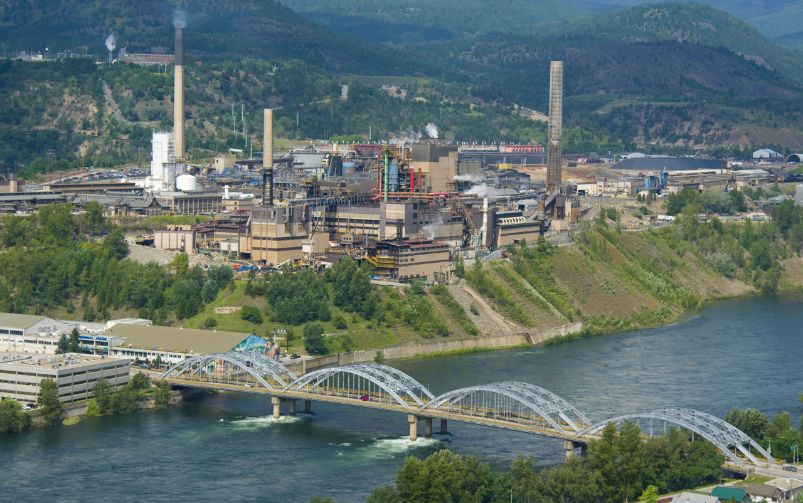Caterpillar’s diesel-powered 793F haul truck at Vale’s Brucutu mine in Minas Gerais, Brazil. As part of a new agreement, Vale and Caterpillar will collaborate on projects like a dual-fuel haul truck powered by diesel and ethanol to reduce emissions. Courtesy of Ricardo Teles/Vale.
Welcome back to your weekly mining news recap, where we catch you up on some of the news you may have missed. This week’s headlines include Australian company St Barbara separating its Canadian assets, AME pushing back on B.C.’s draft mineral claims framework, and Women in Mining Canada’s 2025 Trailblazer Award recipients.
U.S. President Donald Trump signed executive orders to impose 25 per cent tariffs on all steel and aluminum imports coming into the United States, set to take effect on March 12. The White House confirmed that the tariffs would stack on top of 25 per cent tariffs on all Canadian goods, which could come into effect on March 4, raising the total tariff on Canadian steel and aluminum imports to 50 per cent. The planned tariffs are expected to have economic impacts on both sides of the border.
Northwestern Ontario will require 250 megawatts of additional power to meet the demand created by 41 potential mines that are anticipated to be operational by 2033, as reported by Northern Ontario Business. An in-depth analysis of the geographic electrical power needs of the region, conducted by the Northwestern Ontario Municipal Association's Northwest Energy Task Force, highlighted that failing to prepare energy infrastructure for these future mines could deter investors. The task force said that the province must start working now to build or upgrade transmission lines, boost generation capacity, and explore bioenergy options.
Vale and Caterpillar signed a five-year agreement to boost collaboration on productivity, innovation and carbon reduction initiatives. Diesel currently accounts for 15 per cent of Vale's direct carbon dioxide equivalent emissions. To help reduce this, the companies will be working together to develop a dual-fuel haul truck powered by diesel and ethanol. Vale will also test a battery-electric haul truck and Caterpillar’s Dynamic Energy Transfer (DET) system that is under development and currently being trialed with its customers.
Caterpillar’s DET system is just one new charging solution being developed for battery electric vehicles (BEVs) to reduce machine downtime and boost productivity, as reported by Tijana Mitrovic for the February issue of CIM Magazine. The DET system transfers energy to battery electric and electric drive diesel trucks while in operation. Additionally, Komatsu’s WX04B battery electric load-haul-dump machine has a battery swap system that allows for quick charging, and ABB’s eMine Robot Automated Connection Device completely automates the charging process, improving safety.
Following a strategic review of its portfolio, Australia’s St Barbara plans to separate its Atlantic Gold projects in Nova Scotia from the rest of the company, as reported by Engineering News. Atlantic Gold, which includes the past-producing Touquoy mine, along with the 15-Mile, Beaver Dam and Cochrane Hill projects—all of which are currently in the development phase and do not have permits, nor are undergoing environmental assessments—will be separated through a sale, asset vend-in, or demerger into a standalone Canadian company. Post-separation, St Barbara will focus on its Papua New Guinea operations.
The Association for Mineral Exploration (AME) shared that it does not support the B.C. government's draft of the Mineral Claims Consultation Framework, which is set to roll out on March 26 in the province. AME believes that the draft will hinder its members' abilities to stake mineral claims in a “timely and commercially viable manner.” AME will continue to press for amendments to the draft before it is implemented.
Women in Mining Canada announced the winners of its 2025 Trailblazer Awards, recognizing five women who demonstrate leadership and champion diversity and inclusion within the Canadian mining industry. The recipients are Pelangio Exploration’s Ingrid Hibbard, Centerra Gold’s Caroline Sam, University of Toronto student Hannah Eaton-Tessier, Queen’s University student Rebecca Randall and Manitoba Geological Survey’s Tânia Martins.
Barrick Gold exceeded fourth-quarter profit estimates, driven by an increase in production and gold prices, as reported by Reuters. Its gold output rose to 1.08 million ounces in the fourth quarter, up from 1.05 million in the same quarter last year, while average realized gold prices increased to US$2,657 per ounce in the fourth quarter from US$1,986 per ounce in the same quarter the previous year.
Microlearning—which uses short, flexible, hands-on training modules—can improve worker skills in mining, as reported by Alice Martin for the December/January issue of CIM Magazine. A recent study by Training Works, in partnership with the Mining Industry Human Resources Council, Agnico Eagle Mines and Signal Gold, was piloted at two Canadian mine sites. The program, which was focused on safety and communication, reduced safety incidents year-over-year by 46 per cent at one site. The project’s success has spurred plans to expand microlearning across mining and other industries.
Miners have to be creative to get more out of lower-grade ores and complex deposits, especially amidst rising energy and water costs. To address this challenge, companies are advancing particle separation technologies to improve mineral recovery, cut costs and optimize processes, as reported by Silvia Pikal in the December/January issue of CIM Magazine. New technologies include FLS’s REFLUX Flotation Cell, which improves grade and recovery while conserving energy and water; Metso’s MHC Curved Bottom hydrocyclone, which boosts capacity and separation efficiency when compared to its standard hydrocyclone; and Syensqo’s Transfoamer, which adjusts froth strength for improved coarser particle recovery.
That’s all for this week. If you’ve got feedback, you can always reach us at editor@cim.org. If you’ve got something to add, why not join the conversation on our Facebook, Twitter, LinkedIn or Instagram pages?




